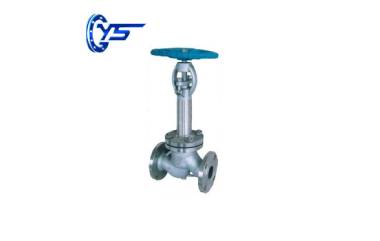Low-temperature valves mainly include gate valves, globe valves, ball valves, etc.
One
The fault occurred at each connection. Low temperature globe valve belongs to this type of failure. The valve packing runs through the freezing point, the flange of the valve seat and the pipeline leaks, and the tin thread at both ends of the valve sleeve leaks. The stem packing is generally in the packing groove where the stem is close to the wall of the cold box. When the packing is uneven, not tight, or the valve stem is not straight or round, low-temperature liquid or gas will leak out along the gap of the packing. Due to the cold transfer, the moisture in the air will freeze on the packing and freeze the valve stem. In this case, the valve can only be opened and closed by heating the packing with steam or hot water.
However, after the valve is opened and closed, the water accumulated in the packing will freeze again. Due to the laborious valve opening and closing, fire-fighting valves often cause the valve stem to twist and the handwheel to rupture. Therefore, after overhauling the valve, the packing should be evenly and tightly tightened and the compression nut tightened. In the overall air separation leak test, you should also check the leakage at the stem packing, and solve this problem before cold driving. Common causes of flange leakage are unsmooth and uneven sealing surfaces, insufficient pipeline compensation, bolts that are not tightened evenly, and bolt materials that are improper. Both ends of the outer sleeve of the valve stem are connected by tin-filled threads, which are prone to cracks and leakage after long-term use. When the pressure test leaks, if such a leak is found, it is best to withdraw the valve stem to refill, tighten, and preferably use silver welding.
The cryogenic valve is a device that should be constantly maintained during the normal operation of the air separation plant. We should have high standards and strict requirements, and maintain it carefully and use it well.

Low Temperature Globe Valve
Two
The fault occurred on the top of the valve. The valve top (valve head) and valve stem of this valve are movably connected, so that the two sealing surfaces can be "aligned automatically" when the low temperature ball valve is closed. After long-term use, titanium, nickel, zirconium, Monel and alloy valves are sometimes damaged due to the anti-return gasket, so that the lock nut is loosened, and finally the valve top is detached when the valve is opened. At this time, the valve will lose its closing effect. Sometimes the damage of the lock nut is caused by improper material, which is replaced by cold and brittle metal. Another common failure is that the valve top is not closed tightly, that is, the valve is leaking. The common cause is that the valve top and the sealing surface of the valve seat are crushed by hard objects (such as silicone, metal shavings, welding slag and other hard objects) to form dents. Under such circumstances, marine valves often use a lot of effort in order to close the valves tightly, which results in increased pressure injuries. Sometimes the valve stem centerline is not perpendicular to the valve seat sealing surface (valve surface), or the valve top and valve surface are worn due to long-term use, which can cause valve leakage.
Three
A failure occurred on the valve stem. The more common fault is the wear of the thread on the valve stem and the screw sleeve, and the ceramic valve prevents the valve from closing. Generally, the thread of the valve stem is not easy to wear, and the female thread on the screw sleeve (brass) is easily damaged. Most of the reasons are that the valve is forced too hard when it is opened, or it is still hardly screwed after opening and closing to the end, causing the screw to bite. Sometimes the screw is completely "biting light", the valve can only be opened, but not closed. To close the valve, the stem can only be pushed inwards with a temporarily added bolt, and then repaired while waiting for maintenance.
To prevent such failures, the most important thing is not to apply too much force when opening and closing the low temperature butterfly valve, and do not open or close hardly.
Copyright © Hebei Yaosheng IM & EX Trading Co.,Ltd. All Rights Reserved |Sitemap | Technical Support: 
